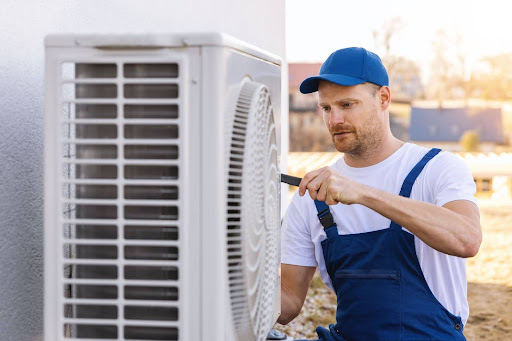The HVAC industry is gearing up for significant changes in 2025 due to new EPA refrigerant regulations, part of a broader initiative to reduce environmental impact and enhance sustainability. These regulations are crucial for both residential and commercial air conditioning systems and revolve around transitioning to low global warming potential (GWP) refrigerants.
AC Refrigerant Regulations
Starting in 2025, the EPA will enforce a 750 GWP limit for refrigerants used in new air conditioning units. This drastic reduction will phase out the common R-410A refrigerant, which has a GWP of 2088, marking it unsuitable for use in new equipment. The transition to lower GWP refrigerants, like R-454B and R-32, will become standard. These refrigerants meet the new environmental requirements and offer lower toxicity ratings compared to older refrigerants.
Ozone Depleting Refrigerants
The shift away from ozone-depleting refrigerants is a response to their significant environmental and health risks. The forthcoming EPA regulations aim to decrease the use of hydrofluorocarbons (HFCs) by 85% by 2036, targeting substances that have been substantial contributors to global warming. The move towards substances like R-454B and R-32 is supported by their lower GWP and safety features conducive to residential use.
Refrigerant Leaks
Under the new regulations, there will be stringent requirements to prevent and manage refrigerant leaks. For instance, systems with refrigerant charges of 15 pounds or more must adhere to fixed leak rate thresholds and repair leaks promptly to comply with environmental safety standards. These measures aim to minimize accidental releases of refrigerants into the atmosphere, which can contribute to ozone depletion and other environmental hazards.
HVAC system maintenance is more crucial than ever, as maintaining systems in accordance with new EPA standards will require updates to ensure they meet the regulatory requirements.
Understanding the AIM Act and Its Impact on Refrigerants
The American Innovation and Manufacturing (AIM) Act is another critical piece of legislation that will significantly impact the HVAC industry by phasing down the use of HFC refrigerants with high GWP over a 14-year period. Under the AIM Act, the production and use of refrigerants like R-410A and R-134a will become increasingly restricted, starting with their use in new HVAC equipment such as chillers, rooftop units, and Variable Refrigerant Flow (VRF) systems.
For example, the use of R-410A in new rooftop units and splits will be banned starting January 1, 2025, with VRF systems following on January 1, 2026. This regulation will affect not only new installations but also the availability of these refrigerants for servicing existing equipment, leading to a likely increase in prices as supply diminishes. Additionally, the AIM Act mandates the use of refillable cylinders for refrigerants beginning January 1, 2025, emphasizing the move towards more sustainable practices in the industry.
As the HVAC industry transitions, staying informed and prepared for these changes will be key to maintaining compliance to ensure the efficiency and longevity of your HVAC system.
How Do EPA HVAC Refrigerant Regulations Impact You?
The new EPA HVAC refrigerant regulations coming into effect in 2025 will have a significant impact on both residential and commercial air conditioning and refrigeration systems. These regulations are part of a broader initiative by the Environmental Protection Agency to reduce the environmental impact of refrigerants with high Global Warming Potential (GWP).
Existing Residential Air Conditioning
For homeowners with existing residential air conditioning systems, particularly those that use older refrigerants like R-22, the new regulations will not require immediate changes. However, as the supply of these older refrigerants continues to dwindle due to EPA mandates, the cost of maintenance and AC repair may rise.
Homeowners may face increased costs if a significant repair is needed, potentially making system replacement with more modern HVAC equipment that uses approved refrigerants a more cost-effective option in the long run.
New Residential Air Conditioning Installations
All new residential air conditioning installations starting in 2025 will need to comply with the new EPA standards. This means they must use refrigerants with a GWP under 750, such as R-32 or R-454B. This shift ensures that newly installed central air conditioners are more environmentally friendly and efficient.
For homeowners planning to install new systems, it’s crucial to consult with HVAC professionals who can make sure that new systems are compliant with the latest EPA HVAC refrigerant regulations.
Existing Commercial Refrigeration and Air Conditioning
The impact on existing commercial refrigeration and air conditioning systems will be similar to the residential impact but on a larger scale. Commercial systems often have larger charges of refrigerants, and the cost implications of maintaining older systems with non-compliant refrigerants can be significant. Businesses may need to plan for retrofitting or replacing older systems to avoid the escalating costs of older refrigerants and to comply with new environmental regulations.
New Commercial Refrigeration and Air Conditioning Installations
For new commercial refrigeration and air conditioning installations, compliance with the 2025 regulations is mandatory. This includes using refrigerants that meet the new GWP limits. The regulation will affect all forms of refrigeration equipment, from large centralized systems to smaller standalone units. Installing compliant systems will not only help in adhering to the law but also in enhancing the energy efficiency and environmental friendliness of commercial operations.
Contact Us for Air Conditioning Services in North Canton, OH, and the Surrounding Areas
Whether you are dealing with residential or commercial systems, the new EPA regulations will necessitate a shift towards more sustainable and environmentally friendly refrigerants. This transition, while potentially costly upfront, is aimed at reducing the overall environmental impact and improving the efficiency of hvac equipment nationwide.
For anyone in North Canton, OH, and the surrounding areas looking to understand more about how these changes might affect your systems, feel free to reach out to us at Quality Heating & Cooling. We’re here to help you navigate these new regulations to keep your air conditioning systems compliant, efficient, and environmentally friendly.




